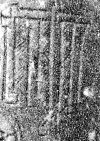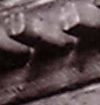

|
Neck

Schematic of the neck decoration. Click for a PDF
The neck or harmonic curve of the Trinity College harp has at least two layers of decoration on each side.
The older layer, which is easily visible on the left side, but almost totally obscured or removed on the right, is a pattern of burned or impressed lines and circles, very much like the decoration on the neck of the Queen Mary harp.
Over the top of this, a complex scheme of deeply carved patterns has been applied, partly respecting the older scheme and partly obliterating it.
There are also silver bosses, which may cover over some of the carved decoration, or may be contemporary with it.
In his 1904 book, R.B. Armstrong was mostly concerned with trying to trace the underlying design of burned or impressed lines and circles, and he published little diagrams showing what he thought the original design might have been. He ignored the overlying intaglio carved designs.

The carved designes on the right side of the neck include carved borders. Armstrong assumed that the carved border lines cover and follow the earlier burned or impressed scheme, and on his drawing he shows burned panels. However, the pairs of carved lines on the right side are closer spaced than the pairs of burned or impressed lines on the left side. Also, in one place I think that part of the original burned or impressed lines can possibly be seen running between the panels, and so I am wondering if the original right hand side burned or impressed lines may have been the same as on the left, a continuous border and not as shown by Armstrong, seperate panels.
In any case, it seems clear that the neck has been re-shaped quite radically, especially at the treble end where the sides of the neck look like they have been planed down to make them flat or narrower. You can especially see at the treble end, the decorative borders just come to a halt. I wonder if the right side of the neck was sanded or scraped to remove the burned or impressed lines before the carved decoration was applied. There certainly seems to be evidence that the metal cheekbands were re-positioned, and the neck may have been shortened.

On the left hand side, at the bass end, is a geometric design that has been interpreted as a gothic black-letter monogram IHC. It is interesting that this religious symbolism is placed on the left side of the harp, which is the less well decorated. Karen Loomis suggested that the right side of the harp was the ‘display’ side, facing the audience, so the left side would be more hidden and less public.
The underside of the neck has beading carved along it, just like on the Queen Mary harp; Armstrong’s soundboard plate includes a profile of this beading.


The end of the neck is covered in a silver cap, with delicately chased and cut sides, and with two large gem settings on. One of these is now empty and one has a quartz crystal. Armstrong's book includes a detailed drawing of this silver end cap.
The neck bears the cheek bands and tuning pins. Joan Rimmer in 1969 said that the pins and cheekbands were of silver, but their colour today is very golden or brassy. The cheek bands have delicate step-patterns engraved on, and the pins have engraved bands around as well as incised patterns on both the drive ends and the string ends. (illustrated here on my antique photo postcard). Some of the pins are more 18th century style with carved quatrefoil ends; others are plainer medieval style; and some are 20th century replacements.
Many thanks to Digital Resources and Imaging Services, Trinity College Dublin, for supplying copies of Dr. Paul Mullarkey’s photographs of the harp.
Simon Chadwick